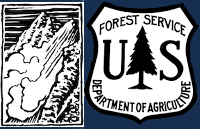Snowpack and Avalanche Discussion
<p><span><span><span><span><span><span>New snow that fell yesterday creates a couple avalanche problems to watch for. </span></span></span></span></span></span><span><span><span><strong><span><span>Wet loose avalanches</span></span></strong></span></span></span><span><span><span><span><span><span> will be easy to trigger when the new snow gets wet from sun and above freezing temperatures. These slides will be larger where there is more new snow, and even just a few inches of wet snow sliding can easily knock you over. These slides are somewhat predictable and typically start right at your skis, feet or sled, making them relatively easy to avoid. However, they can entrain a lot of snow, run long distances and pack a powerful punch if you get caught in one. Plan to be off and out from below steep slopes before the snow surface is moist or wet.</span></span></span></span></span></span></p>
<p><span><span><span><strong><span><span>Wind slab avalanches</span></span></strong></span></span></span><span><span><span><span><span><span> are also possible where westerly winds drift the new snow into stiffer slabs. Increasing winds later today will continue to grow fresh drifts. Watch for snow blowing off ridgelines, or a textured or rounded snow surface as signs of fresh wind slabs. Cracks shooting across the snow from your skis or snowmobile are a sign fresh drifts are unstable. Be cautious of wind-loaded slopes, especially where a slide could drag you into rocks, trees or over cliffs.</span></span></span></span></span></span></p>
<p><span><span><span><strong><span><span>Cornice falls</span></span></strong></span></span></span><span><span><span><span><span><span> are an additional concern to keep in mind. These will become an increasing concern over the next couple days of hotter temperatures and sun. Minimize time on slopes below cornices, especially during the heat of the day, and stay far back from the edge while traveling along ridgelines.</span></span></span></span></span></span></p>
<p><span><span><span><span><span><span>Carefully evaluate the stability of the new snow before traveling on steep slopes. The avalanche danger is MODERATE near Bozeman, Big Sky, West Yellowstone, Island Park and Cooke City.</span></span></span></span></span></span></p>
